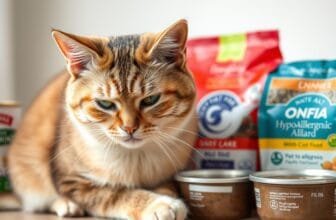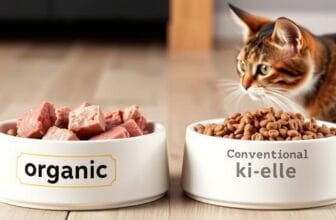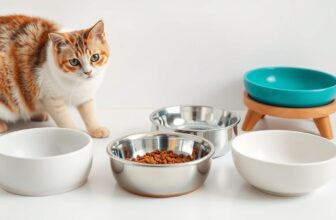
Kittens require specific nutrients in precise amounts to support their developing bodies. Unlike adult cats, they need higher levels of protein, certain amino acids like taurine, essential fatty acids such as DHA, and the right balance of vitamins and minerals to fuel their growth spurts and strengthen their immune systems.
In this comprehensive guide, we’ll explore the top-rated kitten foods specifically formulated to support healthy growth and development. We’ll examine both wet and dry options, compare ingredients, and provide expert insights to help you make an informed decision for your furry family member.
What Makes the Best Kitten Food for Growth and Development?
Before diving into specific product recommendations, it’s important to understand what constitutes high-quality kitten food. Veterinary nutritionists emphasize several key factors that contribute to optimal growth and development:
- High-quality protein sources – Kittens need protein levels between 35-50% of their diet to build strong muscles and support overall growth. Look for named animal proteins (like chicken, turkey, or salmon) as the first ingredients.
- Essential fatty acids – DHA and EPA (omega-3 fatty acids) support brain and eye development. These are typically sourced from fish oil or algae.
- Balanced calcium and phosphorus – These minerals are crucial for proper bone development, with ideal calcium levels between 0.8% to 1.6%.
- Taurine – This essential amino acid strengthens the heart, supports healthy blood flow, and is vital for vision development.
- Appropriate calorie density – Kittens need more calories per pound than adult cats to fuel their rapid growth.
- AAFCO certification – Look for foods that meet the Association of American Feed Control Officials’ nutritional standards for growth or all life stages.

The best kitten food balances these elements in a formula that’s not only nutritionally complete but also palatable for your growing kitten. Now, let’s examine some top-rated options that meet these criteria.
Best Dry Kitten Food for Growth and Development
Dry kitten food offers convenience, dental benefits, and is often more economical than wet food. Here are our top picks for dry kitten food that supports optimal growth and development:
1. Royal Canin Kitten Dry Cat Food

Royal Canin’s kitten formula is specifically designed to support the intense growth period in a kitten’s first year of life. The small, x-shaped kibble is sized perfectly for kitten mouths and helps reduce tartar buildup.
Pros
- Contains DHA from fish oil for brain and vision development
- Balanced protein (38%) and fat content for muscle growth
- Includes prebiotics for digestive health
- Antioxidant complex supports developing immune system
Cons
- Premium price point
- Contains some grain ingredients (may not suit all kittens)
Veterinarians frequently recommend Royal Canin for its research-backed formulations and consistent quality. The precise nutrient profile supports healthy bone development and muscle growth during the critical first year.
2. Blue Buffalo Healthy Growth Kitten Chicken & Brown Rice

Blue Buffalo’s kitten formula features their signature LifeSource Bits—small, dark pieces mixed in with the kibble that contain a precise blend of antioxidants, vitamins, and minerals selected by veterinarians and animal nutritionists.
Pros
- Real deboned chicken as the first ingredient
- Contains DHA and ARA (fatty acids found in mother’s milk)
- No chicken by-product meals, corn, wheat, or soy
- Includes whole grains for digestible carbohydrates
Cons
- Some kittens may not like the texture of LifeSource Bits
- Slightly higher carbohydrate content than some competitors
This formula provides excellent nutritional support for growing kittens with an emphasis on natural ingredients. The balanced calcium and phosphorus levels promote healthy bone growth, while the protein content supports muscle development.
3. Hill’s Science Diet Kitten Healthy Development

Hill’s Science Diet is often recommended by veterinarians for its precisely balanced nutrition. This kitten formula is designed to support brain and eye development while providing optimal levels of minerals for building strong bones.
Pros
- Contains DHA from fish oil for healthy brain and eye development
- High-quality protein for building lean muscle
- Antioxidant blend supports immune system development
- Small kibble size perfect for kitten mouths
Cons
- Contains some grain ingredients
- Higher price point than some competitors
This science-backed formula provides complete and balanced nutrition specifically tailored for kittens up to 1 year of age. The natural ingredients with added vitamins, minerals, and amino acids create an ideal nutritional profile for growing kittens.
Best Wet Kitten Food for Growth and Development
Wet food provides essential hydration and is often more palatable for kittens. It typically contains higher protein and fat with fewer carbohydrates than dry food. Here are our top wet food recommendations:
1. Wellness CORE Natural Grain Free Kitten Formula

Wellness CORE’s grain-free pate is protein-focused nutrition at its best. This formula is designed to mirror a kitten’s natural diet with high-quality animal proteins and nutrient-rich superfoods.
Pros
- Grain-free with 78% more protein than traditional kitten foods
- Contains DHA from salmon oil for brain development
- No artificial colors, flavors, or preservatives
- Includes cranberries for urinary tract health
Cons
- Premium price point
- Rich formula may cause digestive upset in sensitive kittens
This nutrient-dense wet food provides excellent hydration while delivering premium proteins and fats essential for growth. The smooth pate texture is easy for young kittens to eat, making it an excellent choice during the weaning stage and beyond.
2. Royal Canin Kitten Thin Slices in Gravy

Royal Canin’s wet kitten food features thin slices of meat in a rich gravy that’s highly palatable for kittens. The texture is perfect for kittens who prefer chunks over pate and helps the transition from milk to solid food.
Pros
- Thin slices are easy for kittens to chew
- Contains a precise blend of vitamins and minerals
- Highly digestible proteins support growth
- Extra moisture content supports hydration
Cons
- Higher price per ounce than some competitors
- Contains by-products (though these can be nutritious)
This formula is specifically designed to intensify the flavor and aroma to appeal to a kitten’s developing senses. The balanced nutrition supports immune system development while the texture encourages healthy eating habits.
3. Fancy Feast Kitten Tender Ocean Whitefish Feast

Fancy Feast’s kitten formula offers excellent value while maintaining good nutritional quality. This ocean whitefish recipe provides essential protein and omega-3 fatty acids in a smooth pate that’s easy for kittens to eat.
Pros
- Ocean whitefish as the first ingredient
- Contains milk for added calcium
- Highly palatable for picky eaters
- Excellent price point
Cons
- Contains some by-products
- Includes artificial colors
This budget-friendly option doesn’t compromise on the essential nutrients kittens need for growth. The smooth texture and appealing flavor make it a favorite among kittens, while the nutrient profile supports healthy development.
Best Grain-Free Kitten Food for Sensitive Stomachs
Merrick Purrfect Bistro Grain-Free Kitten Recipe

For kittens with sensitive digestion or grain allergies, Merrick’s Purrfect Bistro offers a high-protein, grain-free formula that’s gentle on the stomach while providing excellent nutrition for growth and development.

Pros
- 74% protein from animal sources
- Deboned chicken as the first ingredient
- Contains omega-3 and omega-6 fatty acids for skin and coat health
- Includes probiotics for digestive support
- No grains, corn, wheat, soy, or gluten
Cons
- Higher price point than some grain-inclusive options
- Some kittens may need time to adjust to the rich formula
This grain-free formula is particularly beneficial for kittens showing signs of food sensitivities. The high-quality animal proteins and added probiotics make it easier to digest while supporting the development of lean muscle mass.
Kitten Food Comparison: Finding the Best for Growth and Development
To help you make an informed decision, we’ve compiled this comparison table of our top recommended kitten foods. This at-a-glance reference highlights key nutritional factors that support growth and development.
| Product | Type | Protein % | Fat % | DHA/Omega-3 | Grain-Free | Price Range |
| Royal Canin Kitten Dry | Dry | 38% | 20% | Yes | No | $$$ |
| Blue Buffalo Healthy Growth | Dry | 36% | 18% | Yes | No | $$ |
| Hill’s Science Diet Kitten | Dry | 33% | 19% | Yes | No | $$$ |
| Wellness CORE Kitten | Wet | 12%* | 7%* | Yes | Yes | $$$ |
| Royal Canin Kitten Wet | Wet | 10%* | 4%* | Yes | No | $$$ |
| Fancy Feast Kitten | Wet | 11%* | 5%* | Yes | No | $ |
| Merrick Purrfect Bistro | Dry | 42% | 20% | Yes | Yes | $$ |
*Note: Wet food percentages appear lower due to high moisture content. On a dry matter basis (with moisture removed), protein and fat percentages are comparable to or higher than dry food.

Kitten Feeding Guide: How Much and How Often
Proper feeding amounts and schedules are just as important as choosing the right food. Here’s a general guide to help you establish healthy feeding routines for your growing kitten:
| Age | Feeding Frequency | Approximate Amount (Dry) | Approximate Amount (Wet) |
| 6-8 weeks | 4-6 times daily | 1/4 – 1/3 cup | 2-3 oz |
| 8-12 weeks | 3-4 times daily | 1/3 – 1/2 cup | 3-4 oz |
| 3-6 months | 2-3 times daily | 1/2 – 2/3 cup | 4-6 oz |
| 6-12 months | 2 times daily | 2/3 – 3/4 cup | 6-8 oz |

Important feeding tips:
- Always follow the specific feeding guidelines on your chosen food’s packaging, as calorie content varies between brands.
- Adjust portions based on your kitten’s activity level, growth rate, and body condition.
- Free feeding (leaving food available all day) works for some kittens but can lead to overeating in others.
- A combination of wet and dry food often provides the best nutritional balance.
- Fresh water should always be available.
Monitor your kitten’s weight and body condition regularly. You should be able to feel but not see their ribs, and they should have a visible waist when viewed from above. If you’re concerned about your kitten’s growth rate or eating habits, consult your veterinarian.
Transitioning to Adult Cat Food: When and How
Knowing when and how to transition your kitten to adult cat food is an important part of their nutritional journey. Most kittens can begin transitioning to adult food around 12 months of age, though some larger breeds may benefit from kitten food for up to 18 months.

When it’s time to make the switch, follow this gradual transition schedule to avoid digestive upset:
- Days 1-2: 75% kitten food mixed with 25% adult cat food
- Days 3-5: 50% kitten food mixed with 50% adult cat food
- Days 6-7: 25% kitten food mixed with 75% adult cat food
- Day 8 and beyond: 100% adult cat food
Signs that your kitten is ready for adult food include reaching their adult size, decreased activity level, or approaching their first birthday. If you’re unsure, consult with your veterinarian about the right time to make the transition based on your specific cat’s development.
Buyer’s Guide: How to Choose the Best Kitten Food for Growth and Development
With so many options available, selecting the right kitten food can feel overwhelming. Here’s what to look for when evaluating kitten food for optimal growth and development:

Essential Nutritional Factors
- AAFCO Statement: Look for “complete and balanced for growth” or “all life stages”
- Protein Content: Minimum 35% for dry food, 10% for wet food (higher on a dry matter basis)
- Fat Content: Minimum 18% for dry food, 5% for wet food
- DHA: Essential for brain and eye development
- Taurine: Critical amino acid for heart and eye health
- Calcium and Phosphorus: For proper bone development
- Vitamins A, E, and D: Support immune function and overall growth
Quality Indicators
- Named Protein Sources: Look for specific proteins like “chicken” rather than generic “meat”
- Whole Food Ingredients: Real foods rather than heavily processed ingredients
- Limited Fillers: Minimal use of corn, wheat, and soy products
- No Artificial Preservatives: Avoid BHA, BHT, and ethoxyquin
- No Artificial Colors: These offer no nutritional benefit
- Appropriate Calorie Density: Higher than adult food to support growth
- Moisture Content: Higher is better, especially for kittens prone to urinary issues
Special Considerations
Grain-Free vs. Grain-Inclusive
Unless your kitten has a specific grain allergy or sensitivity, either option can provide excellent nutrition. Grain-free isn’t necessarily better, but it may be appropriate for kittens with certain digestive issues.
Wet vs. Dry Food
Ideally, feed a combination of both. Wet food provides hydration and is often more protein-rich, while dry food supports dental health and offers convenience. A mix provides balanced nutrition.
Budget Considerations
While premium foods often contain higher-quality ingredients, many mid-range options provide excellent nutrition. Focus on ingredient quality and AAFCO compliance rather than price alone.
Need Personalized Recommendations?
Your veterinarian is the best resource for personalized nutritional advice based on your kitten’s specific health needs, breed, and growth pattern.
Frequently Asked Questions About Kitten Food for Growth and Development
How much should I feed my kitten?
Feeding amounts vary based on your kitten’s age, weight, and the specific food you’re using. As a general guideline, kittens 6-12 weeks old need about 1/4 to 1/3 cup of dry food per day, divided into multiple meals. Kittens 3-6 months old need approximately 1/3 to 1/2 cup daily, while those 6-12 months need about 1/2 to 2/3 cup. Always check the feeding guidelines on your specific food’s packaging and adjust based on your kitten’s growth and body condition.
When should I switch from kitten food to adult cat food?
Most kittens can transition to adult cat food around 12 months of age when they’ve reached their adult size. Larger breeds like Maine Coons may benefit from kitten food for up to 18 months. Make the transition gradually over 7-10 days by slowly increasing the ratio of adult food to kitten food to prevent digestive upset.
Is wet or dry food better for kittens?
Ideally, kittens should eat both wet and dry food. Wet food provides essential moisture and is often higher in protein, while dry food supports dental health and offers convenience. A combination feeding approach ensures your kitten receives the benefits of both food types. If you can only provide one type, wet food generally offers better hydration and higher protein content for growing kittens.
Do kittens need special food, or can they eat adult cat food?
Kittens should eat food specifically formulated for growth or all life stages. Kitten food contains higher levels of protein, fat, and certain nutrients like DHA that are essential for proper development. Adult cat food typically doesn’t provide the calorie density or nutrient profile needed to support a kitten’s rapid growth and development.
How can I tell if my kitten is getting proper nutrition?
Signs of good nutrition include steady weight gain, a shiny coat, clear eyes, good energy levels, and regular bowel movements. Your kitten should be playful and alert, with a healthy appetite. During regular veterinary check-ups, your vet will assess your kitten’s growth curve and body condition to ensure they’re developing properly. If you notice weight loss, lethargy, dull coat, or digestive issues, consult your veterinarian as these could indicate nutritional deficiencies.
Is grain-free food better for kittens?
Grain-free food isn’t necessarily better for all kittens. While some kittens with specific allergies or sensitivities may benefit from grain-free formulas, most healthy kittens can digest properly processed grains without issues. The overall quality of protein sources and nutrient balance is more important than whether the food contains grains. Always choose foods that meet AAFCO standards for growth or all life stages, regardless of grain content.
How often should I feed my kitten?
Feeding frequency depends on your kitten’s age. Very young kittens (6-12 weeks) should eat 4-6 small meals daily. From 3-6 months, reduce to 3-4 meals daily. By 6 months, most kittens can transition to 2-3 meals per day. By one year, twice-daily feeding is typically sufficient. Some pet parents practice free-feeding with dry food, but scheduled meals help monitor intake and establish routine.

Conclusion: Investing in Your Kitten’s Future Health
Choosing the best kitten food for growth and development is one of the most important investments you can make in your cat’s long-term health. The nutrition your kitten receives during their first year establishes the foundation for their adult life, influencing everything from bone strength to immune function.
Whether you choose premium options like Royal Canin and Wellness CORE or more budget-friendly alternatives like Fancy Feast’s kitten line, the key is selecting a food that meets AAFCO standards for growth or all life stages and contains high-quality protein sources, essential fatty acids like DHA, and appropriate levels of vitamins and minerals.
Remember that individual kittens may have different preferences and needs. Monitor your kitten’s growth, energy levels, and overall health, and don’t hesitate to consult with your veterinarian if you have concerns about their development or nutritional requirements.
By providing optimal nutrition during this critical growth period, you’re giving your kitten the best possible start in life and setting the stage for many healthy, happy years together.
Ready to Give Your Kitten the Best Start in Life?
Explore our top-recommended kitten foods and find the perfect match for your growing feline friend.







